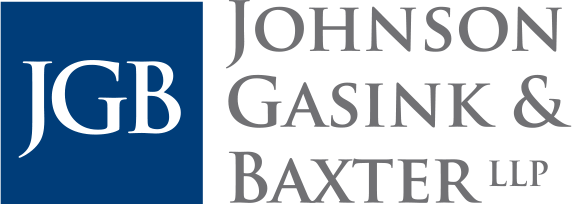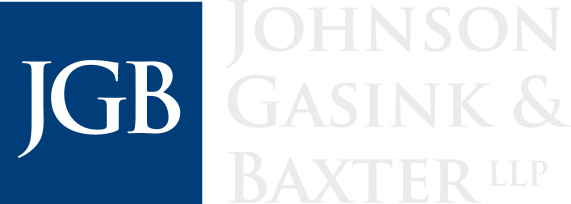JGB September 2023 Newsletter
SECURE Act 2.0 – Building on the SECURE Act
The Setting Every Community Up for Retirement Enhancement Act (SECURE Act) was passed in 2019 with the goal of making it easier for Americans to save for retirement. Congress then passed additional reforms late last year with the SECURE 2.0 Act of 2022 (SECURE 2.0). As the name implies, SECURE 2.0 provided clarifications to and built on the SECURE Act; and they are together changing the landscape of retirement planning. There are also implications that extend into the realm of estate planning and administration, including different options for inheriting your spouse’s IRA. While a comprehensive summary of the SECURE Act and SECURE 2.0 is beyond the scope of this article, some of the provisions most pertinent to estate planning and estate administration are detailed below.
Required Minimum Distribution (RMD) Age Increases
The SECURE Act increased the age at which individuals must start taking RMD payments out of their retirement plans from 70½ years old to 72. SECURE 2.0 then raised the age even higher, to 73 for individuals who turn 72 after the end of 2022 and then to age 75 for everybody else, starting in 2033. What does this mean for you? If you were born in 1950 or earlier, there is no change and you should continue taking required distributions. For those born from 1951 to 1959, required minimum distributions are not required to be taken until age 73; and for those born 1960 or later, distributions are not required until age 75.
New Option for Surviving Spouses Inheriting IRAs
Before the SECURE Act, any beneficiary could "stretch" the distributions from an inherited IRA over their own life expectancy, potentially withdrawing funds from the account for the rest of their life and delaying any taxes owed. Now, however, most non-spouse beneficiaries will need to fully deplete the inherited IRA within 10 years. There are exceptions to this requirement for “Eligible Designated Beneficiaries” (EDBs, which are defined as surviving spouses, minor children of the deceased account owner, beneficiaries less than ten years younger than the account owner, disabled individuals, and chronically ill individuals) to stretch distributions over their life expectancy. An EDB is permitted to stretch the distributions from an inherited IRA over their own life expectancy. Starting in 2024, SECURE 2.0 provides a new option for surviving spouses where they may elect to be treated just like the original owner – their spouse –with any RMD timing set to the age of the deceased spouse, not the survivor. This would allow penalty-free distributions sooner if the deceased spouse is younger than the surviving spouse. Additionally, if a surviving spouse dies before required distributions begin on the deceased spouse’s IRA, the surviving spouse’s beneficiaries are treated as if they were the original beneficiaries of the original account holder. This allows any of these beneficiaries who could be classified as Eligible Designated Beneficiaries to stretch distributions over their life expectancy. Which option is best depends on each particular couple’s circumstance and ages, with either designation having potential benefit.
Increased Flexibility of College Saving Plans by Allowing Rollovers to a Roth IRA
Beginning in 2024, SECURE 2.0 permits repurposing unused 529 College Savings Plan (529 plan) funds without incurring taxes or penalties by rolling them over to a Roth IRA. Quite a few conditions must be met, however, and not all 529 plan funds will qualify. Some of the requirements and limitations include:
- The 529 plan must be at least 15 years old;
- The Roth IRA must belong to the 529 plan’s beneficiary;
- The Roth owner must have earned income to support the contribution and the total amount contributed to the Roth must be within the annual limit (in 2023, the limits are the lesser of the beneficiary’s earned income or $6,500 dollars);
- No funds (or their associated earnings) that were contributed within the last 5 years can be used; and
- The lifetime maximum that a beneficiary may transfer is $35,000.
Qualified Charitable Distributions
Since 2006, account holders who are at least 70½ have been allowed to direct that up to $100,000 per year be distributed to a charitable organization from their IRA. This is known as a qualified charitable distribution (QCD). The amount that is donated counts towards the individual’s required minimum distribution but is excluded from taxable income. SECURE 2.0 provides that this $100,000 annual QCD limit will be indexed annually for inflation. SECURE 2.0 also expands the rules to allow a one-time QCD of up to $50,000 to a charitable remainder unitrust, charitable remainder annuity trust, or a charitable gift annuity. There are several restrictions that make this opportunity impractical for most people currently.
Special Needs Trusts
A special needs trust, also known as a supplemental needs trust (SNT), allows assets to be left in trust to help take care of individuals who are disabled or chronically ill without disqualifying them from certain public benefits such as Medicaid and Supplemental Security Income (SSI). Under SECURE 2.0, charities that are qualified as 501(c)(3) charitable organizations can be named as remainder beneficiaries of an SNT that is funded with retirement accounts without compromising the favorable “stretch” payout timeframe available to the disabled or ill individual named as the trust’s primary beneficiary. Private foundations, donor advised funds, supporting organizations, and split-interest trusts will not qualify for the favorable treatment provided under this provision.
Navigating the Path Forward
SECURE 2.0 contains over 90 provisions intended to promote savings, boost incentives for businesses to promote retirement savings, and offer more flexibility to those saving for retirement. Some of the measures enacted but not discussed in this article include:
- Reducing the penalty for failure to take required minimum distributions
- Additional exceptions to the penalty on early distributions from qualified plans
- Expanding automatic enrollment in retirement plans and improving coverage for parttime workers
- Removing required minimum distribution barriers of life annuities.
- Increasing catch-up contribution limits.
- Treatment of student loan payments as elective deferrals for purposes of employer matching contributions to retirement plans
- Modification of age requirement for qualified ABLE programs from 26 to 46 beginning in 2026
The IRS has not yet released the final regulations for the SECURE Act or SECURE 2.0, but it is very clear that the IRA landscape is now more complex than ever. There is much ambiguity in how these new laws will be implemented, and the IRS has been rolling out guidance for some of the particularly confusing portions. Last year, Notice 2022-53 noted that final RMD regulations will apply no earlier than the 2023 distribution calendar year. Notice 2023-54 added another year of relief by excusing 2023 missed RMDs for noneligible designated beneficiaries of IRA owners who died in 2020 or 2021. And just last week, Notice 2023-62 clarified some of the requirements set in place for catch‑up contributions. This article only highlights a few of the many changes ushered in with SECURE 2.0. If you are interested in reading more about this legislation, click here for a summary of each section of the law. For JGB TrustGuard™ clients, in addition to our normal annual review items and updates, we will certainly be addressing the impact of the SECURE Act and SECURE 2.0 on your trust plans with you.
If you are not a JGB TrustGuard™ client and have not had a document review since 2020, then you should consider scheduling a document review appointment with your JGB attorney to discuss whether the SECURE Act affects your estate plan. We also recommend that you stay in touch with your trusted financial advisor or accountant to help ensure that you avoid potential pitfalls and garner the most advantage you can from these sweeping new provisions.


